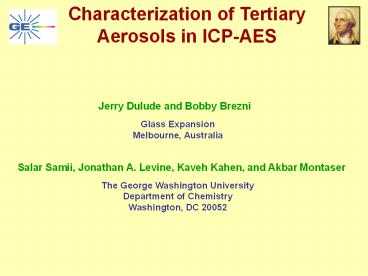Characterization of Tertiary Aerosols in ICP-AES - PowerPoint PPT Presentation
Title:
Characterization of Tertiary Aerosols in ICP-AES
Description:
Size range = 0.5 to 680 mm. Velocity range = -585 to 585 m/sec ... Distance from Neb (mm) Rel. Speed. cyclonic. Mini-cyclonic. Effect of Dissolved Salts ... – PowerPoint PPT presentation
Number of Views:138
Avg rating:3.0/5.0
Title: Characterization of Tertiary Aerosols in ICP-AES
1
Characterization of Tertiary Aerosols in ICP-AES
Jerry Dulude and Bobby Brezni
Glass Expansion Melbourne, Australia
Salar Samii, Jonathan A. Levine, Kaveh Kahen, and
Akbar Montaser
The George Washington University Department of
Chemistry Washington, DC 20052
2
Overview
- Purpose to characterize primary tertiary
aerosols related to ICP-AES ICP-MS - Methods gravimetric and optical measurements
- Results Droplet size transport efficiency are
related to gas flow, nebulizer and spray chamber
design, and transport efficiency.
3
Introduction
The nature of the aerosol mist typically
generated by the combination of a nebulizer and
spray chamber has a pronounced effect on the
performance of the ICP atomic emission
spectrometer into which it is directed. This
work reports on the relationships between the
efficiency of the sample introduction system and
the mean droplet size including the effect of
nebulizer gas velocity and salt content.
4
Definitions
B
- Primary Aerosol the aerosol that exits from the
nebulizer (A) - Tertiary Aerosol the aerosol that exits from the
spray chamber (B) - Waste (W) A-B
- Transport Eff. of nebulized sample leaving the
chamber
A
W
5
ExperimentalTransport Efficiency
For each nebulizer/spray chamber combination
- Aspirate solution for an appropriate time period
using self-aspiration. - Measure by weight the mass of solution consumed.
- Measure by weight the mass of solution collected
at the drain. - The difference between 2 and 3 is the transport
efficiency.
6
Measurement of Droplet Size Distributions
- The Phase Doppler Particle Analyzer was used
- Simultaneous measurement of size velocity
- Size range 0.5 to 680 mm
- Velocity range -585 to 585 m/sec
7
The Phase Doppler Particle Analyzer
Transmitting probe
Ar laser
Fiberoptics light coupler
Measurement volume
Receiver optics
Computer
PMT detectors
Measurement electronics
8
Transport Efficiency Study
7 different nebulizers run at 1.0LPM gas flow and
their natural uptake rate.
Uptake rate (ml/min)
Nebulizer P/N
AR30-1-FC2E 2.1
AR30-1-FC1E 1.4
AR30-1-FM06E 0.61
AR30-1-FM04E 0.50
AR30-1-FM02E 0.27
AR30-1-FM01E 0.11
AR30-1-FM005E 0.03
9
Transport Efficiency vs. Uptake
EFFICIENCY
UPTAKE RATE (ML/MIN)
10
Tertiary Flow Rate vs. Uptake
Tertiary Flow Rate (ul/min)
11
Corroboration of Tertiary Flow Rates
Uptake rate (ml/min) This work (mg/min) Todoli paper (mg/min)
0.03 15 14
0.11 23 21
- Todoli, Hernandis, Canals, and Mermet, JAAS,
1999, 14, 1289-1295 - Using GE MicroMist nebulizer with U-tube
absorption for measurement
12
Inter-nebulizer Variability of Transport
Efficiency (AR30-07-FC2E)
DIFFERENT NEBULIZERS OF SAME MODEL
3.6RSD
13
Effect of Gas Flow Rate48 Increase in Efficiency
NEBULIZER GAS FLOW RATE (LPM)
AR30-07-FC2E
AR30-1-FC2E
43 increase in analyte dilution in the plasma
14
Effect of Gas Pressure
NEBULIZER GAS PRESSURE (PSIG)
15
Effect of Spray Chamber Design
92
79
16
Spray Chamber Designs
Cyclonic Tracey
Baffled Cyclonic Twister
Mini-Cyclonic Cinnabar
17
Effect of Chamber Volume
Rel. Speed
cyclonic
Mini-cyclonic
Distance from Neb (mm)
18
Effect of Dissolved SaltsConikal at 2ml/min
uptake
92
89
19
Primary Aerosol Size Distribution
Nebulizer Gas Flow Rate 1.0 L/Min Solution
Uptake Rate Natural Aspiration
Normalized Count
Normalized Volume
MicroMist (FM005E)
10
10
20
30
40
50
0
20
30
40
50
60
0
60
Diameter (mm)
Diameter (mm)
20
Tertiary Aerosol Size Distribution
Nebulizer Gas Flow Rate 1.0 L/Min Solution
Uptake Rate Natural Aspiration
Baffled Cyclonic Spray Chamber
Normalized Count
0
10
20
40
30
50
Diameter (mm)
21
Conclusions
- Uptake of 0.6 ml/min gives max tertiary transport
- Baffled spray chamber lowers cutoff droplet size
- Salts lower transport efficiency
- Low uptake produces smaller primary D32
- No effect on tertiary D32

